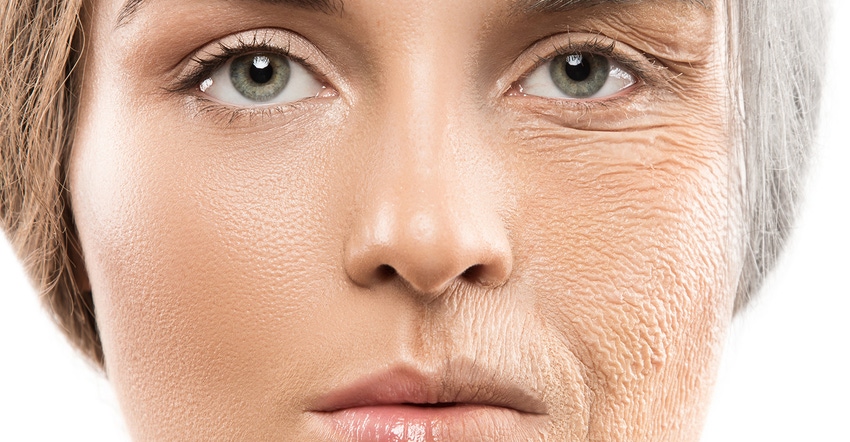Learning from pathways of cellular aging
As the average human lifespan increases, discoveries about cellular aging may provide keys to achieve beneficial effects across multiple health outcomes.

Although a debate still exists whether the human lifespan has a natural upper limit,1 human life expectancy has been increasing throughout recent history.2Amongst other things, this can be linked to developments in medicine and improvements in public health. It is also clear that diet and lifestyle can have significant effects on health and the way people age.3
The fact that more people are living for longer also means more people are living long enough to suffer from one or more age-related diseases, as age is a major risk factor for many conditions. As such, a need exists to improve the health of older people in society, as well as to maintain health as people age. Failure to do so will obviously place a significant burden on aging individuals, and this burden extends beyond individuals to their families and society as a whole given the need to provide and pay for caregiving and medical interventions. Combined with concordant aging population demographics2 and rising health care costs,4 this challenge has the potential to provide a perfect storm, which could have crippling effects on societies and economies.
Many hallmarks of aging occur within the cells, such as the accumulation of DNA mutations, the shortening of telomeres, the accumulation of protein aggregates, as well as changes to the epigenetic landscape of people’s genomes.5 This accumulation of damage and disorder no doubt contribute toward the emergence of age-related conditions. However, it seems the accumulation is not a solely random process, and opportunities are available to influence its progress. This evidence comes from research in model organisms—from invertebrates such as nematode worms or fruit flies, all the way through to mammals, including rodents and primates—which has shown that mutations in single genes, or interventions that target these genes and their pathways, can extend lifespan significantly, and delay or prevent the onset of age-related conditions.6,7 This offers real hope that treatments that improve the underlying process of cellular aging may achieve beneficial effects across multiple health outcomes, all in one go.
Perhaps the most well-known and long-established anti-aging intervention is dietary or calorie restriction, which was first shown to increase the lifespan of rodents in the 1930s.8 Dietary restriction not only extends the lifespan of rodents, but also delays the onset of age-related declines and diseases.9,10 Similar anti-aging benefits of calorie restriction have since been demonstrated in multiple other model organisms, including yeast,11 nematode worms12 and fruit flies.13 Indeed, despite some conflicting results, evidence also supports beneficial effects on lifespan—or perhaps more accurately, healthspan—in organisms much closer to humans, such as rhesus monkeys.14
Given beneficial effects in such a broad array of organisms, research is exploring if similar interventions have the same benefits in humans. Although, for obvious reasons, assessment on the impact of long-term dietary restriction in humans in controlled studies is lacking, epidemiological data and short-term studies do support many of the same responses occurring.15,16,17
Calorie restriction could be the answer to improving health as people age. Certainly, given rising obesity rates and the negative effects on health this imparts,18 reducing caloric intake would contribute to overall better health of some populations. However, more specifically in terms of healthy aging of individuals, although in principle a relatively simple intervention, long-term dietary restriction may not be the easiest, and indeed not the most appealing intervention to maintain. Other intermittent fasting approaches—consuming fewer or even no calories on intermittent days,19,20 or consuming calories within a restricted time period each day21—may offer many, if not all, of the benefits of restricting calories without being quite so arduous. However, these would still require significant modifications to people’s lifestyles.
Research into longevity and aging in model organisms has expanded since the early 1980s, when the first mutations in single genes that extended lifespan were identified in nematode worms.22 These genes turned out to be within the invertebrate’s insulin/insulin-like growth-factor-like signalling (IIS) pathways,23,24 for which mutations in equivalent pathways were subsequently shown to also have lifespan-extending effects in other organisms, including fruit flies25 and rodents.26 Since then, many other genes and pathways that extend lifespan have been identified,6,7 including the target of rapamycin (TOR) pathway, which is the target for one of the better-known anti-aging ingredients resveratrol.27 The prevalence of genes involved in pathways related to nutrients and energy demonstrates it is not just important which nutrients people put into their bodies, but also how these nutrients are sensed and metabolized in the cells.
The fact that the same genes and treatments show similar beneficial effects in such different organisms is a testament to the fact that pathways of cellular aging are well conserved across broad evolutionary distances. This suggests promise exists in taking the target genes and treatments identified and applying them to the development of interventions that support healthier human aging. Such development is not without significant challenges, not least of all how to demonstrate the benefit of interventions in controlled studies, but as noted above, an increasingly pressing need is emerging to maintain and improve the health of older members of society. Therefore, any steps that can be taken to augment proper diet and lifestyle choices could make a significant contribution to individuals’ health, as well as that of society.
Editor’s Note: Kieron Edwards will be speaking at SupplySide West 2019 as part of the Healthy Aging: Antioxidants, Adaptogens & Cognition session, Wednesday, Oct. 16, from 9 a.m. to noon. For more information or to register, visit supplysideshow.com.
Kieron Edwards is the chief scientific officer for Sibelius Natural Products. Using its proprietary Chronoscreen platform, Sibelius takes a science-led approach to uncover the potential and provide insights into the impact of natural ingredients on age-related conditions. After completing his doctorate in plant genetics, Edwards gained over 10 years’ experience in biological research in academic and industrial settings. He has used genetics, genomics, transcriptomics and other systems approaches to investigate the regulation of physiological and biochemical traits in biological systems. In addition to his scientific training, Edwards also completed his master’s of business administration at the University of Cambridge.
References
1. Dong X, Milholland B, Vijg J. "Evidence for a limit to human lifespan." Nature. 2016;538:257-259.
2. United Nations, Department of Economics and Social Affairs & Population Division. World population ageing, 2017 highlights.
3. Haveman-Nies A. "Dietary quality, lifestyle factors and healthy ageing in Europe: the SENECA study." Age Ageing. 2003;32:427-434.
4. DiMasi JA, Grabowski HG, Hansen RW. "Innovation in the pharmaceutical industry: New estimates of R&D costs." J. Health Econ. 2016;47:20–33.
5. López-Otín C et al. "The Hallmarks of Aging." Cell. 2013;153:1194-1217.
6. Partridge L. "The new biology of ageing." Philos. Trans. R. Soc. B Biol. Sci. 2010;365:147-154.
7. Nikoletopoulou V, Kyriakakis E, Tavernarakis N. "Cellular and molecular longevity pathways: the old and the new." Trends Endocrinol. Metab. 2014;25:212-223.
8. McCay CM, Crowell MP, Maynakd LA. "The Effect of Retarded Growth Upon the Length of Life Span and Upon the Unltimate Body Size." J. Nutr. 1935;10:63-79.
9. Weindruch R et al. "The Retardation of Aging in Mice by Dietary Restriction: Longevity, Cancer, Immunity and Lifetime Energy Intake." J. Nutr. 1986;116:641-654.
10. Longo VD, Fontana L. "Calorie restriction and cancer prevention: metabolic and molecular mechanisms." Trends Pharmacol. Sci. 2010;31:89-98.
11. Jiang JC et al. "An intervention resembling caloric restriction prolongs life span and retards aging in yeast." FASEB J. 2000;14:2135-2137.
12. Klass, MR. "Aging in the nematode Caenorhabditis elegans: Major biological and environmental factors influencing life span." Mech. Ageing Dev. 1977;6:413-429.
13. Chippindale AK et al. "Phenotypic plasticity and selection in Drosophila life-history evolution. I. Nutrition and the cost of reproduction." J. Evol. Biol. 1993;6:171-193.
14. Mattison JA et al. "Caloric restriction improves health and survival of rhesus monkeys." Nat. Commun. 2017;8.
15. Most J et al. "Calorie restriction in humans: An update." Ageing Res. Rev. 2017;39:36-45.
16. Balasubramanian P, Howell PR, Anderson RM. "Aging and Caloric Restriction Research: A Biological Perspective With Translational Potential." EBioMedicine. 2017;21:37-44.
17. Holloszy JO, Fontana L. "Caloric restriction in humans." Exp. Gerontol. 2007;42:709-712.
18. Pischon T et al. "General and Abdominal Adiposity and Risk of Death in Europe." N. Engl. J. Med. 2008;359:2105-2120.
19. Wei M et al. "Fasting-mimicking diet and marker/risk factors for ageing, diabetes, cancer, and cardiovascular disease." Sci. Transl. Med. 2017;9:1112.
20. Johnson JB, Laub DR, John S. "The effect on health of alternate day calorie restriction: Eating less and more than needed on alternate days prolongs life." Med. Hypotheses. 2006;67:209-211.
21. Longo VD, Panda S. "Fasting, Circadian Rhythms, and Time-Restricted Feeding in Healthy Lifespan." Cell Metab. 2016;23:1048-1059.
22. Klass MR. "A method for the isolation of longevity mutants in the nematode Caenorhabditis elegans and initial results." Mech. Ageing Dev. 1983;22:279-286.
23. Kimura KD et al. "daf-2, an Insulin Receptor–Like Gene That Regulates Longevity and Diapause in Caenorhabditis elegans." Science. 1997;277(5328):942-946.
24. Lin K et al. "daf- 16: An H N F-3/forkhead Family Member That Can Function to Double the Life-Span of Caenorhabditis elegans." Science. 1997;278(5341):1319-1322.
25. Tatar M et al. "A Mutant Drosophila Insulin Receptor Homolog That Extends Life-Span and Impairs Neuroendocrine Function." Science. 2001;292(5514):107-110.
26. Bluher M, Kahn BB, Kahn CR. "Extended Longevity in Mice Lacking the Insulin Receptor in Adipose Tissue." Science. 2003;299:572-574.
27. Liu M et al. "Resveratrol Inhibits mTOR Signaling by Promoting the Interaction between mTOR and DEPTOR." J. Biol. Chem. 2010;285:36387-36394.
About the Author(s)
You May Also Like






.png?width=800&auto=webp&quality=80&disable=upscale)